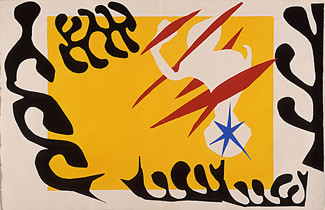Matisse on Paper
13 Jan - 20 Apr 2008

© Henri Matisse (France, 1869–1954)
Le Cauchemar de l'éléphant blanc (from Jazz), 1947
Print, Stencil print, Sheet: 16 1/2 x 25 1/2 in. (41.91 x 64.77 cm)
Purchased with funds provided by James and Ilene Nathan (M.86.198.4)
Le Cauchemar de l'éléphant blanc (from Jazz), 1947
Print, Stencil print, Sheet: 16 1/2 x 25 1/2 in. (41.91 x 64.77 cm)
Purchased with funds provided by James and Ilene Nathan (M.86.198.4)
MATISSE ON PAPER
January 13, 2008–April 20, 2008
Ahmanson Building, Plaza Level
Besides being one of the greatest artists of the twentieth century, Henri Matisse (1869–1954) was also one of its greatest draftsmen. The works on paper in this gallery, covering nearly thirty years (from the 1920s to the 1950s) of the artist's long career, display the full range of his facility with charcoal, graphite, and ink, as well as with the sister arts of printmaking and collage, both of which he treated as extensions of drawing.
In every medium in which he worked, Matisse investigated form primarily through the vehicle of the female, in particular the odalisque, or reclining female nude. Many of his most imaginative and graceful drawings depict odalisques in a seemingly endless variety of poses. Matisse wrote that his models were "never just 'extras' in an interior. They are the principal theme of my work . . . The emotional interest aroused in me by them does not appear . . . in the representation of their bodies, but . . . rather in the lines or . . . values distributed over the whole canvas or paper, which form its complete orchestration, its architecture."
In his last two decades, Matisse practiced the art of the paper cutout, a technique he invented to compensate for his increased infirmity after surgery that left him a semi-invalid. Using scissors and colored paper, he engaged in some of his most radical experiments with form and color, light and space. Towards the end of his life, he wrote, "I have found the cutout to be the simplest and most direct way to express myself."
January 13, 2008–April 20, 2008
Ahmanson Building, Plaza Level
Besides being one of the greatest artists of the twentieth century, Henri Matisse (1869–1954) was also one of its greatest draftsmen. The works on paper in this gallery, covering nearly thirty years (from the 1920s to the 1950s) of the artist's long career, display the full range of his facility with charcoal, graphite, and ink, as well as with the sister arts of printmaking and collage, both of which he treated as extensions of drawing.
In every medium in which he worked, Matisse investigated form primarily through the vehicle of the female, in particular the odalisque, or reclining female nude. Many of his most imaginative and graceful drawings depict odalisques in a seemingly endless variety of poses. Matisse wrote that his models were "never just 'extras' in an interior. They are the principal theme of my work . . . The emotional interest aroused in me by them does not appear . . . in the representation of their bodies, but . . . rather in the lines or . . . values distributed over the whole canvas or paper, which form its complete orchestration, its architecture."
In his last two decades, Matisse practiced the art of the paper cutout, a technique he invented to compensate for his increased infirmity after surgery that left him a semi-invalid. Using scissors and colored paper, he engaged in some of his most radical experiments with form and color, light and space. Towards the end of his life, he wrote, "I have found the cutout to be the simplest and most direct way to express myself."
